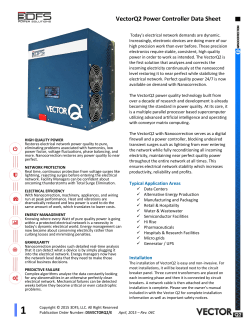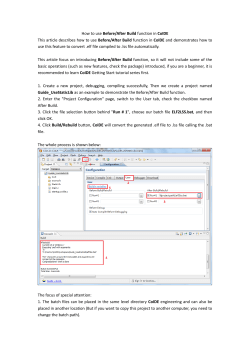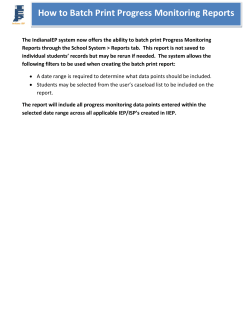
Ephesoft Advanced Reporting Tool
Ephesoft Advanced Reporting Tool Installation Guide 1 Table of Contents Ephesoft Advanced Reporting Tool ................................................................................ 3 Installation ......................................................................................................................... 4 Prerequisites ................................................................................................................... 4 Installation ....................................................................................................................... 4 Configuration .................................................................................................................... 5 Ephesoft Report Data Location ....................................................................................... 5 Database Connectivity .................................................................................................... 5 File Patterns of the End State XML Files ......................................................................... 5 Users .............................................................................................................................. 6 Custom Column Headers ................................................................................................ 6 Document and Field Filters.............................................................................................. 7 2 Ephesoft Advanced Reporting Tool Ephesoft Advanced Reporting Tool is an Ephesoft add-on. It aids administrators in achieving the goal of reducing manual data corrections. To do this, the Reporting Tool monitors Ephesoft’s performance over time and captures information about the correction process in order to identify where potential bottlenecks may be. It generates detailed reporting on the performance of Ephesoft’s document capture system to provide insight into needed adjustments to the system’s classification, extraction rules, and thresholds. As a result the system can be fine-tuned for maximum performance and increased ROI. 3 Installation Prerequisites The Reporting Tool currently utilizes a MySQL or Microsoft SQL Server database and runs on Tomcat. For certain installation steps, be sure to follow only the instructions for the type of database you will be using (MySQL or Microsoft SQL Server). In order to minimize impact on the Ephesoft instance that is being used, it is recommended to not deploy the Reporting Tool on the Ephesoft Tomcat server. It is also recommended to create a separate database instance as well. If installing from a .zip file, be sure that file has been unzipped and contains the Ephesoft Advanced Reporting Tool’s User Guide, this Ephesoft Advanced Reporting Tool Installation Guide and the Database, Properties and War directories. If downloading these files from the Ephesoft Advanced Reporting Tool Alfresco site, the Ephesoft Advanced Reporting Tool User Guide and this Ephesoft Advanced Reporting Tool Installation Guide can be found in the 'User Guides' directory. The Database, Properties and War directories can be found in the 'Installation Package' directory. Be sure to choose the 'MySQL Scripts' or 'MS SQL Server Scripts' sub-directory in the Database and Properties directories, depending on which database you are using. Installation 1. Create the batch_class_reporting database: a. Run the create_db.sql and create_db_objects.sql scripts, found in the ‘Database’ directory of the installation package. From this directory, run the following 2 commands (where PASSWORD is the root user's password): a.i. If using MySQL: a.i.1. ‘mysql –uroot –pPASSWORD < create_db.sql’ a.i.2. ‘mysql –uroot –pPASSWORD batch_class_reporting < create_db_objects.sql’ a.ii. If using Microsoft SQL Server: a.ii.1. ‘sqlcmd -U USERNAME -P PASSWORD -i create_datebase.sql’ a.ii.2. ‘sqlcmd -U USERNAME -P PASSWORD -i create_database_objects.sql’ 2. Shut down Tomcat. 3. Place the properties files in the Tomcat classpath: a. Place these files batch-class-analysis.properties, favicon.ico, column_header_config.properties, filter.properties, log4j.properties, and users.properties, found in the ‘Properties’ directory in the installation package, in the TOMCAT_HOME/lib directory. 4 a.i. If you are using MySQL, also add the mysql_queries.properties file to the TOMCAT_HOME/lib directory. a.ii. If you are using Microsoft SQL Server, add the sqlserver_queries.properties file to the TOMCAT_HOME/lib directory. b. The configurable files will be further described in the next sections of this documentation. 4. Place the Reporting Tool war file, found in the ‘War’ directory of the installation package, in TOMCAT_HOME/webapps. 5. Start Tomcat. Configuration Ephesoft Report Data Location The report data location for Ephesoft is set in the batch-class-analysis.properties file. Simply point the ephesoft.report.data.dir property to Ephesoft's reportdata directory. The default value for this is: ephesoft.report.data.dir=c:/Ephesoft/SharedFolders/report-data Database Connectivity Database connectivity is configured in the batch-class-analysis.properties file. The Ephesoft and Ephesoft Advanced Reporting Tool databases should be separate in order to reduce load on Ephesoft. The ephesoft.jdbc.url points to the Ephesoft database, while the bca.jdbc.url should point to the database created in the installation steps above. Provide a username and password for each database connection. File Patterns of the End State XML Files The file patterns for the end state .xml files can be configured in the batch-classanalysis.properties file. These .xml files are created by Ephesoft and by default can be found in Ephesoft/SharedFolders/report-data/<BATCH_INSTANCE>/. The batch-class-analysis.properties file contains regular expressions that need to correspond with particular .xml files created by Ephesoft. If using a custom configuration of Ephesoft, these regular expressions may need to be changed accordingly. The default values are: bca.final.end.state.pattern=Export_Module_Scripting_Plugin_batch_bak bca.extraction.end.state.pattern=Extraction_Module_Scripting_Plugin_batch_bak bca.pre.review.end.state.pattern=Document_Assembler_Module_Scripting_Plugin_batch_ bak 5 Users The users.properties file contains the username and password information for the Reporting Tool users. To configure users, simply set the number of users, and provide a user.N and pass.N for each user. This property-driven authentication will be replaced by LDAP/Active Directory integration in a future release. Custom Column Headers The column_header_config.properties file provides a way to customize column names within the Reporting Tool reports. If the administrator would prefer to see “Document Correction Count” over ‘document corrections,” he or she would build the following String in the properties file: table.1.document\ corrections=Document Correction Count where ‘1’ refers to the Correction Report, ‘document\ corrections’ refers to the original name of the column, and ‘Document Correction Count’ is the preferred alternative. Property keys require that all spaces/whitespaces are escaped. Values do not need to be escaped. Each report corresponds to a number: Documents Processed Report - 1 Correction Report - 2 Document Correction Report - 3 Classification Correction Report - 4 Separation Correction Report - 5 Unnecessary Review Report - 6 False Positive Report - 7 Field Corrections Report - 8 Field Correction Detail Report - 9 Page Correction Report - 10 Batch Report – 11 To replace a column named external_batch_instance_id in the Field Correction Detail report with the column name “Batch ID,” one would add the following line to the column_header_config.properties file: table.8.external_batch_instance_id=Batch ID Using these customizations, it is possible to modify all headers on all reports in order to best meet business needs. 6 Document and Field Filters The filter.properties file allows the administrator to exclude both Document Types and Field Names from the Ephesoft Advanced Reporting Tool. These Field Names and Document Types can simply be entered as a comma separated list after the field.name.filter and doc.type.filter keys. 7 www.ephesoft.com Copyright © 2013 Ephesoft All Rights Reserved 8
© Copyright 2025












